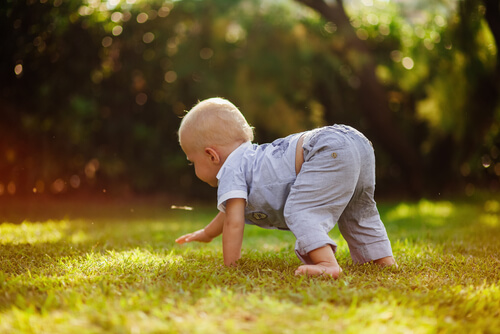Benefits of Crawling for Babies

In today’s article we’d like to discuss the multiple benefits of crawling for babies.
When we see our baby gaining strength and confidence in their movements, and it seems like they want to launch themselves onto the floor, we long for the moment when they learn to crawl.
However, some parents have to wait a while for this moment as their little one doesn’t seem to want to crawl just yet.
Crawling is an essential part of your baby’s motor skills. It’s very important that they acquire the confidence and strength needed to learn to walk.
Despite this, there is no standard age for them to learn to crawl. Every child is different and learns at their own speed.
There are a variety of reasons that babies might not be crawling yet. The age to begin to crawl is between 7 and 9 months.
However, not every baby passes through the crawling stage. Some children may not crawl until after having learned to walk.
Don’t worry if your child isn’t crawling yet. However, it’s important to observe the conditions that have led to this.
For example, if in addition to not crawling they seem to have other problems with their legs or motor coordination in general, it would be a good idea to visit the pediatrician.
The importance of stimuli to learn to crawl
As we mentioned above, unless there is a health problem, it’s normal for some babies not to crawl when you expect them to. Specialists say that stimuli from the parents can significantly influence crawling in this stage.

When they turn six months old, most children begin to show signs of independence. They become restless, get up, jump, and seem to be more active.
In this stage, crawling usually occurs because their motor system begins to be ready to move.
Babies crawl because they want to move but don’t know how to walk yet. It comes from their desire to go to an area that seems interesting.
However, a baby that isn’t motivated to crawl will never be able to do it. Unless your baby crawls of their own free will, they’ll need some help. They need to feel safe on a firm surface.
Benefits of crawling before walking
Although it’s common for some babies to walk without ever having crawled, crawling offers multiple benefits.
The position to crawl encourages speed, confidence and determination. Similarly, crawling is part of the evolutionary human process because it requires the activation of both brain hemispheres.
When your baby crawls, they learn to coordinate their movements within their brain. Other benefits of this process include:
- Encourages elasticity in hands and ankles
- Stimulates tactile sense

- Promotes balance
- Encourages strengthening of the digestive system
- Visual benefits
- Creates strength in the muscular-skeletal structure column
- Strengthens the motor system needed to walk
- Stimulates the resistance of the cardiovascular system
Every baby is different and learns in their own time. That’s why you shouldn’t worry if your baby takes a while to crawl.
In any case, if you notice your child hasn’t started crawling yet, we encourage you to stimulate them.
Direct them towards a toy, have them follow you, or put them into a crawling position.
You can also have them imitate you, showing them how to crawl. Let them move towards wherever they want, as long as they are safe and being monitored.
Don’t worry too much if your healthy baby learns and develops in their own way. You should just provide them the tools they need.
All cited sources were thoroughly reviewed by our team to ensure their quality, reliability, currency, and validity. The bibliography of this article was considered reliable and of academic or scientific accuracy.
- López, S. (2012). La importancia del Gateo. Psicoactua,(30), 2-1. http://www.psicoactua.com/webcms/usuario/documentos/20121105174143_Importancia%20del%20gateo.pdf
- Ojeda Alberca, E. (2018). El gateo en el desarrollo cognitivo en niños menores de 2 años. http://repositorio.untumbes.edu.pe/handle/UNITUMBES/731
- Quipo Guaranda, J. M. (2017). La importancia del gateo y su incidencia en la escritura de las niñas y niños del Centro Infantil del Buen Vivir Jilgueritos de la parroquia San Francisco de Borja, cantón Quijos, provincia de Napo (Bachelor’s thesis, Universidad Técnica de Ambato. Facultad de Ciencias Humanas y de la Educación. Carrera de Parvularia). https://repositorio.uta.edu.ec/handle/123456789/24919
This text is provided for informational purposes only and does not replace consultation with a professional. If in doubt, consult your specialist.








